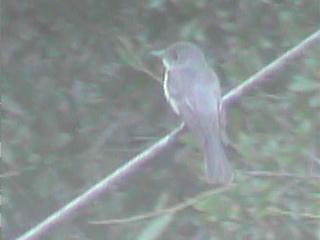Some very interesting shots were taken early on 8/27. Here’s the one that I think shows the bird best, taken by txbird:
In the chat log (yay! I love the chat log!), rafa speculated about it being an Empidonax or Cantopus flycatcher (presumably an Eastern Wood Peewee in the latter case). But idbirds responded that it looked more like an Eastern Phoebe, and I think I agree. I’m not seeing the wingbars I’d expect to see otherwise.
What do you think?

Agreed, Eastern Phoebe. Besides no wing bars, see how rounded the back of the head appears. In my experience, the back of the head on empidonax and cantopus flycatchers tends to have a squarish-to-almost-pointed/crested look. On the Welder checklist, Eastern Phoebe is the most common flycatcher, except for Scissor-tail!
I requested some Id. Help from the birders on Texbirds list. Thans a lot to all them! These are the results:
Eastern Phoebe: 2
Eastern Wood-Pewee: 3
Empidonax sp.: 3
Some of their reasons:
“I lived on the Welder for three years recently doing my masters on birds and fire. Phoebes begin arriving there this time of year and are very tame, compared to a Willow flycatcher. I never found eastern pewee that I can recall.”
Ken Mix
“ The last photo looks like an empid with a long bill, probably Dusky, Gray or Acadian, whichever is the most likely for your area. I don’t know where that is. Definitely not a phoebe or pewee with that obvious an eye-ring.”
Carolyn
“All I can say about the flycatcher is that it is definitely NOT of the Sayornis genus.
It seems to be lacking the wing pattern of an Empid but the picture quality is not good enough to say for certain. The angle is bad too.
Based on tail length and bill size and color, I would be inclined to lean towards a Contopus Flycatcher. I can’t say for certain though.
Happy Birding!” –Chris
“I would guess Eastern Wood-pewee for the second one. It is definately not an Empidonax Flycatcher which would rule out willow and the birds dorsal surface looks too dark overall for Eastern Phoebe.”
Brady Surber
Alpine, TX
“While I can’t discern your flycatcher, my guess would be one of the Empidonax sp. just based on the time of year. These flycatchers move through in large numbers during August. Phoebes show up more heavily in September, although it is not terribly unusual to see them occasionally during the summer months. I can’t rule out pewee though.”
Jeff McIntyre
Pflugerville, TX
“Other bird strikes me as a Wood-Pewee. Wing bars and overall color not quite right for Phoebe. Not nearly bold enough an eye-ring for an Empid like Willow.
Good birding”
Josh
“As for the other flycatcher, not as good a photo, but I think it is an Eastern Phoebe, perhaps a juvenile. While the photo quality is not great, I would think that the wing-bars of a pewee or Empidonax would be clearly visible if that is what the bird was. This bird shows only the barest hint of any kind of light edging to the flight feathers and no wing-bars. It also seems to be the right color for a Phoebe, has a dark head like a Phoebe, and shows great contrast between the upperparts and underparts, which is consistent with Phoebe, and unlike pewees and Empidonax, which generally show much less contrast.”
Paul Sunby
Austin, Texas
[…] showed (see the excellent summary of Texas birder comments posted by Rafa in the comments to the earlier item), but we now have a number of images that have achieved the standard for a consensus ID of Eastern […]